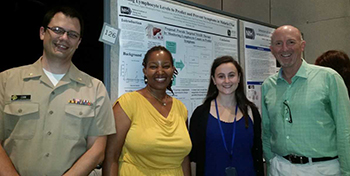The Training Page
My Summer of Learning…and…Surprises…at the NIH
“Elana, you are here first and foremost to learn,” National Institute of Allergy and Infectious Diseases staff clinician Agnes Mwakingwe-Omari told me on the first day of my summer internship with the Laboratory of Malaria Immunology and Vaccinology (LMIV).
And so, during my first few weeks, I read paper after paper after paper until I wasn’t just familiar with our malaria vaccine protocol but I was well informed about other malaria vaccine experiments worldwide. I learned how and why some attempts had failed and others showed promise. Then, my PI and the clinicians in the lab explained the immunological basis for our malaria chemoprophylaxis vaccine, CVac.

Summer intern Elana Shaw (third from left) took part in the 2018 Summer Poster Day, held on August 9. Members of her lab stopped by to show their support. Pictured, from left: David Cook, Agnes Mwakingwe-Omari (PI), Elana, and Patrick Duffy.
The CVac regimen calls for three monthly intravenous injections containing live malaria parasites. During those three months, participants are given antimalarial drugs to control which parasitic life-stages they are exposed to. Ideally, the CVac regimen would both provide protective immunity against future malaria infections and give scientists a glimpse into how the immune system reacts to different stages of the parasite’s life-cycle.
I quickly learned, however, that promising scientific logic is meaningless without a massive amount of manpower, organization, and teamwork to bring it to fruition. To start, it was extremely difficult to recruit patients for the phase 1 trial. As part of the recruitment team, I called hundreds of numbers provided by the Office of Patient Recruitment, hung posters at the NIH and local colleges, manned tables at farmers’ markets, and even plastered fliers in bathroom stalls. All of this to, hopefully, recruit 10 individuals.
Recruiting for the study taught me how to effectively explain the LMIV’s complicated CVac protocol to people from a wide variety of backgrounds. The search for patients forced me to become comfortable talking to people about their medical histories.
Recruitment also helped me to fully understand the impact of the LMIV’s malaria vaccine research by putting faces to the disease. Through conversations with potential volunteers, I was astonished to find that, in Bethesda, I am surrounded by people who have been personally affected by malaria. These individuals told me their stories and conveyed passions for finding a malaria vaccine equal to or surpassing those being developed by the LMIV scientists.
Unfortunately, one of the exclusion criteria for our study was having had a diagnosis of malaria within the past 10 years. Consequently, many of our most ardent potential volunteers were unable to participate in the trial. However, they all expressed gratitude for and excitement about the LMIV’s malaria vaccine research and offered to help in any way they could. One young man, who had suffered from malaria as a child when he was living in Africa, even offered to help advertise for our trials in the future.
During my time as an intern for the LMIV, I learned more than I ever could have imagined about humanity, medicine, and clinical research. I even got to conduct my own research on an oddly foreboding drop in blood lymphocyte concentrations that tends to occur before people experience malaria symptoms.
However, the coolest part of having been an intern for the LMIV is yet to occur. I expect that one day, when I am reading the newspaper, I will come across an article celebrating a malaria vaccine that has over 90 percent efficacy. The LMIV will have made it and I will be incredibly proud of all the study recruitment posters I valiantly placed in bathroom stalls and of my small role in the gargantuan battle against malaria.
Elana Shaw is a junior, majoring in chemistry, at Emory University (Atlanta, Georgia). During the summer of 2018, she worked as an intern in NIAID and helped to recruit for the clinical trial called “Sanaria PfSPZ Challenge with Pyrimethamine Chemoprophylaxis (PfSPZ-CVac Approach): Phase 1 Dose Escalation Trial to Determine Safety and Development of Protective Efficacy after Exposure to only Pre-erythrocytic Stages of Plasmodium falciparum.”
This page was last updated on Wednesday, April 6, 2022
